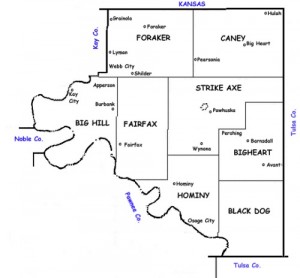Oil boom 1920s lease auctions earned the Osage millions.
By the 1920s, Oklahoma’s petroleum exploration leases auctioned in the shade of a “Million Dollar Elm” brought prosperity to the Osage Nation. Production from Osage County alone launched the careers of Frank Phillips, J. Paul Getty, Bill Skelly, E.W. Marland, Harry Sinclair — and Clark Gable.
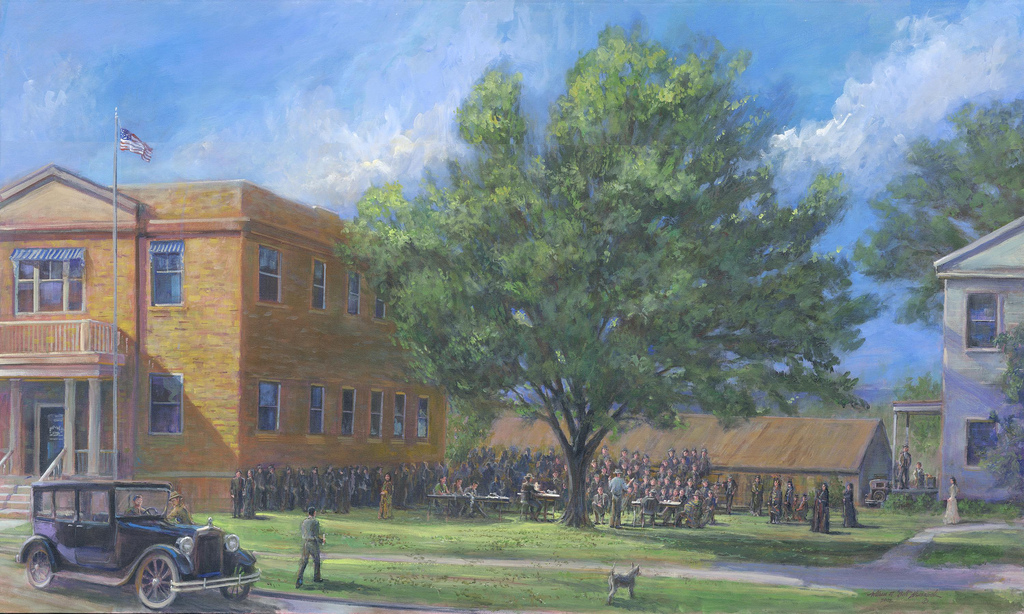
A circa 1920s painting depicts one of the many lease auctions that took place under the “Million Dollar Elm” next to the Osage Nation tribal council house in Pawhuska, Oklahoma.
In the spring of 2003, the Osage nation opened a “Million Dollar Elm” casino a few miles from its council house at Pawhuska, Oklahoma. The name came straight from Osage reservation petroleum history. Multi-million dollar lease auctions took place in the shade of a giant elm next to the council house.
Osage County, at more 2,250 square miles, is the largest county in Oklahoma – larger than Delaware or Rhode Island. On the grounds atop Agency Hill between the county courthouse and the Osage tribal council house, today stands a symbolic elm where auctions regularly took place on hot summer afternoons.
Soon after Oklahoma statehood, more Osage discoveries brought thousands to Bartlesville, Hominy, Fairfax, Grainola and Burbank. All the oilfields produced a high-quality, easily refined oil. First drilled in 1920, the Burbank field and several others soon became one of the richest in Oklahoma.
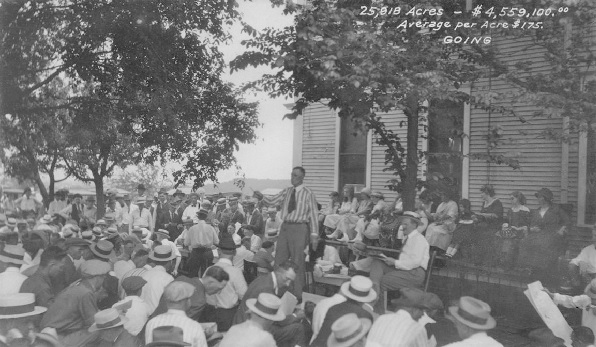
Colonel Elmer Ellsworth Walters, official auctioneer of the Osage Nation (seen here on June 14, 1921), sold millions of dollars of oil leases in the shade of an elm tree. Photo courtesy Bartlesville Area History Museum.
At its peak, the Burbank oilfield produced more than 70,000 barrels a day from more than 1,800 wells. Phillips Petroleum made a fortune there. Other petroleum companies got their start in Osage oilfields, including Conoco (originally Marland Oil), Skelly Oil, Carter Oil (later incorporated into Standard Oil), and Gypsy Oil Company (later Gulf).
Traces of oil had long been noted in the area, including slicks on creeks and oil seeps. The southern end of the Flint Hills, which ranges down from Kansas, has rocks 298 million years old, according to Jenk Jones Jr. of the Tallgrass Prairie National Preserve in Cottonwood Falls, Kansas.
The Indian Territory Illuminating Oil Company made the first drilling deal with the Osage Tribe, he noted in 1991. The oil company received rights to all drilling in the Osage Nation for 10 years, beginning in 1896. The next year the territory’s first commercial producer was completed, the Nellie Johnstone No. 1 well, in what is now a park in Bartlesville.
All of Osage County was open for bidding after 1916 – just in time for the greatest years of the Osage boom, triggered by demands of World War I and the postwar growth in automobiles.
“To get a sense of how the oil business exploded in the Osage, there were about 6,000 barrels produced in 1900, more than 11 million in 1914. The Osage boom and a vast leap in the number of automobiles coincided remarkably well,” Jones explained in a Tulsa World article.
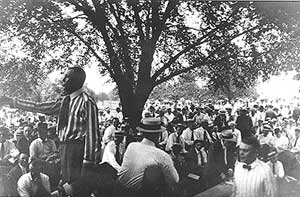
Colonel Walters on March 2, 1922, sold a million-dollar 160-acre oil lease for the Osage Nation. Walters auctioned another 160-acre Osage lease for $2 million in 1924. Detail of photo in Oil! Titan of the Southwest by Carl Coke Rister, 1949.
During the height of the drilling boom from 1919 to 1928 northwest of Tulsa, more than $202 million was paid to the tribe in oil and natural gas royalties, bonuses, interest and land rentals.
“The Osage fields were an oilman’s dream,” reported Jones. “The oil was a high-grade, with a good conversion to gasoline ratio. It was easily refined, with a very high percentage of kerosene. It was free of sulfur and asphalt.”
According to Corey Bone of the Oklahoma Historical Society, the profitable auctions of Osage mineral rights were based on “headrights” from a 1906 tribal population count.
“Unlike other landholders, the Osage were able to retain collective ownership of subsurface mineral rights, rather than having to accept allotments to individual owners,” Bone explained. “Instead, tribal members received ‘headrights’ that assured them an equal share of mineral rights sales equivalent to income from 658 acres.”
She added that a headright could not be sold, but an individual could sell his or her surface rights. “An average Osage family of a husband, wife, and three children would receive more than $65,000 a year in 1926,” Bone noted.
By 1939, Osage individuals had received more than $100 million in royalties and bonuses.
Million Dollar Auctioneer
Great petroleum wealth for the Osage people brought criminal conspiracies — and the murder of Osage for headrights to their land. The murders eventually led to an FBI investigation, convictions — and changes to the law in 1925.
When the “Reign of Terror” news finally made national headlines, it obscured the the good work of a longtime friend and respected auctioneer of the tribe’s leases. The Osage would erect a statue to their auctioneer, Colonel Elmer Ellsworth Walters, in his hometown of Skedee.
Born in at the end of the Civil War in 1865, his parents had named him after the first Union martyr of the Civil War, Col. Elmer Ellsworth of the 11th New York Volunteers. His friendship helped earn the Osage millions of dollars (learn about Walters, his leases auctions, the dark history of Osage headrights in Million Dollar Auctioneer.
As the auctioneer for the Osage, Walters worked for about $10 a day, beginning in 1912. Later, surrounded by bidding oil company owners E.W. Marland, William Skelly and the Phillips brothers, he regularly set new lease sales records.
Walters would become greatly admired among the Osage of Pawhuska. “He knew the oilmen intimately and was an expert at getting them to raise bids,” Jones explained. “So subtle were their signals that L.E. Phillips reportedly ‘bid’ $100,000 for a lease by brushing a fly away from his nose.”
The elm’s name was not given by tribal leaders – but by reporters and magazine writers who were dramatizing the events when founders of the world’s greatest oil companies came in person to bid. It truly earned its name when 18 tracts brought bonuses of $1 million on a single day, November 11, 1912.
Auctions by Walters would earn about $157 million for the Osage tribe by 1928, two years after the Osage Nation dedicated a statue to their auctioneer, Colonel Elmer Ellsworth Walters, in his hometown of Skedee. The statue depicts the auctioneer shaking hands with his friend Osage Chief Bacon Rind.
Osage Oil Boom
A large cast of national characters are linked to petroleum exploration and production on the Osage Nation. Future president Herbert Hoover, an orphan, spent summer months in Pawhuska after his uncle Major Lahan J. Miles was appointed agent to the Osages in 1878.
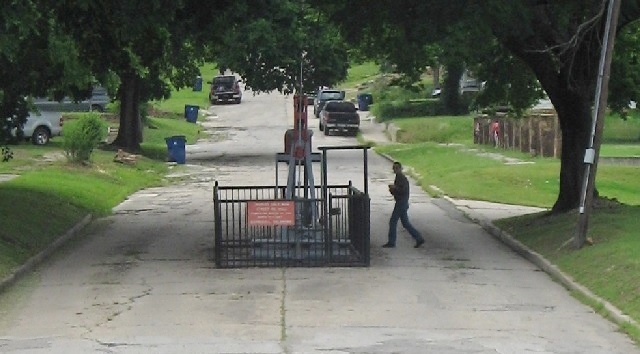
Visitors to Barnsdall, Oklahoma, can view a registered petroleum landmark in the middle of Main Street that is considered to be the only such oil well in the world. Photo by Bruce Wells.
Southeast of Pawhuska, the town Pershing was an oil boom town named for Gen. John J. Pershing, leader of U.S. forces in Europe during World War I.
Tom Mix, future silent film star, was a town marshal in Dewey just east of the Osage County border. The Wild West show of the 101 Ranch in Kay County west of the Osage gave him the boost that sent him to Hollywood.
Clark Gable worked as a roustabout in the Osage oilfields, especially around Barnsdall and Pershing, before heading to California for stardom (see Boom Town Burkburnett).
Memories of what took place beneath the Osage Nation elm did not fade after the original tree died in the 1980s. The latest elm, dedicated during a September 15, 2006, ceremony, grows new roots into the historic site. Visitors gamble at six Osage Nation “Million Dollar Elm” casinos.
In 2011, Oklahoma City-based Chaparral Energy reportedly began working on methods to increase production from Osage oilfields that could bring $11 billion to Osage County and provide the Osage Nation with $1.2 billion in royalty payments over the next 30 years.
Editor’s Note: Special thanks to Jenk Jones Jr. and his March 1, 2003, “Osage County History” docent orientation presentation, Tallgrass Prairie National Preserve, Cottonwood Falls, Kansas.
_______________________
Recommended Reading: The Underground Reservation: Osage Oil (1985); Oil in Oklahoma
(1976); Killers of the Flower Moon (2018). Your Amazon purchase benefits the American Oil & Gas Historical Society. As an Amazon Associate, AOGHS earns a commission from qualifying purchases.
_______________________
The American Oil & Gas Historical Society preserves U.S. petroleum history. Please become an AOGHS annual supporter and help maintain this energy education website and expand historical research. For more information, contact bawells@aoghs.org. © 2025 Bruce A. Wells. All rights reserved.
Citation Information – Article Title: “Million Dollar Elm,” Authors: B.A. Wells and K.L. Wells. Website Name: American Oil & Gas Historical Society. URL: https://aoghs.org/petroleum-pioneers/million-dollar-elm. Last Updated: April 20, 2025. Original Published Date: March 24, 2014.


